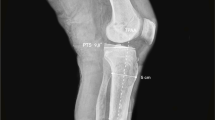Abstract
Purpose
The purpose of this cadaveric study was to study the effect of plane of osteotomy on incidence of lateral cortex fracture and to define a “safe zone” through which medial open-wedge high tibial osteotomy (HTO) could be performed with minimal risk of lateral cortex fracture.
Methods
Medial open HTO was performed in nine fresh frozen human cadavers (18 knees) with each specimen randomly assigned to a “safe zone” osteotomy (group A, between the tip of the fibular head and the circumference line of the fibular head,) or a lower level osteotomy (group B, distal to the circumference line of the fibular head).
Results
Six out of nine knees developed lateral cortex fracture in group B compared to none in group A (P = 0.009) when the osteotomy site was distracted to a maximum of 20 mm.
Conclusion
Directing the plane of the osteotomy toward the “safe zone” significantly reduces the risk of lateral cortex fracture compared to an osteotomy, which is directed at a lower level. Confining the plane of a medial open HTO to within the “safe zone” can prevent lateral cortex fracture and subsequent loss of correction.




Similar content being viewed by others
References
Berman AT, Bosacco SJ, Kirshner S, Avolio A Jr (1991) Factors influencing long-term results in high tibial osteotomy. Clin Orthop Relat Res 272:192–198
Brinkman JM, Lobenhoffer P, Agneskirchner JD, Staubli AE, Wymenga AB, van Heerwaarden RJ (2008) Osteotomies around the knee: patient selection, stability of fixation and bone healing in high tibial osteotomies. J Bone Joint Surg Br 90:1548–1557
Chae DJ, Shetty GM, Wang KH, Montalban AS Jr, Kim JI, Nha KW (2011) Early complications of medial opening wedge high tibial osteotomy using autologous tricortical iliac bone graft and T-plate fixation. Knee 18:278–284
El-Assal MA, Khalifa YE, Abdel-Hamid MM, Said HG, Bakr HM (2010) Opening-wedge high tibial osteotomy without bone graft. Knee Surg Sports Traumatol Arthrosc 18:961–966
Hernigou P, Medevielle D, Debeyre J, Goutallier D (1987) Proximal tibial osteotomy for osteoarthritis with varus deformity. A ten to thirteen-year follow-up study. J Bone Joint Surg Am 69:332–354
Jacobi M, Wahl P, Jakob RP (2010) Avoiding intraoperative complications in open-wedge high tibial valgus osteotomy: technical advancement. Knee Surg Sports Traumatol Arthrosc 18:200–203
Kazimoğlu C, Akdoğan Y, Sener M, Kurtulmuş A, Karapınar H, Uzun B (2008) Which is the best fixation method for lateral cortex disruption in the medial open wedge high tibial osteotomy? A biomechanical study. Knee 15:305–308
Kessler OC, Jacob HA, Romero J (2002) Avoidance of medial cortical fracture in high tibial osteotomy: improved technique. Clin Orthop Relat Res 395:180–185
Lobenhoffer P, Agneskirchner JD (2003) Improvements in surgical technique of valgus high tibial osteotomy. Knee Surg Sports Traumatol Arthrosc 11:132–138
Meidinger G, Imhoff AB, Paul J, Kirchhoff C, Sauerschnig M, Hinterwimmer S (2011) May smokers and overweight patients be treated with a medial open-wedge HTO? Risk factors for non-union. Knee Surg Sports Traumatol Arthrosc 19:333–339
Miller BS, Dorsey WO, Bryant CR, Austin JC (2005) The effect of lateral cortex disruption and repair on the stability of the medial opening wedge high tibial osteotomy. Am J Sports Med 33:1552–1557
Miller BS, Downie B, McDonough EB, Wojtys EM (2009) Complications after medial opening wedge high tibial osteotomy. Arthroscopy 25:639–646
Nelissen EM, van Langelaan EJ, Nelissen RG (2010) Stability of medial opening wedge high tibial osteotomy: a failure analysis. Int Orthop 34:217–223
Rose T, Imhoff AB (2007) Complications after transgenicular osteotomies. Oper Tech Orthop 17:80–86
Spahn G, Kirschbaum S, Kahl E (2006) Factors that influence high tibial osteotomy results in patients with medial gonarthritis: a score to predict results. Osteoarthr Cartil 14:190–195
Spahn G, Mückley T, Kahl E, Hofmann GO (2006) Biomechanical investigation of different internal fixations in medial opening-wedge high tibial osteotomy. Clin Biomech (Bristol, Avon) 21:272–278
Spahn G (2004) Complications in high tibial (medial opening wedge) osteotomy. Arch Orthop Trauma Surg 124:649–653
van Raaij TM, Brouwer RW, de Vlieger R, Reijman M, Verhaar JA (2008) Opposite cortical fracture in high tibial osteotomy: lateral closing compared to the medial opening wedge technique. Acta Orthop 79:508–514
Acknowledgments
This study is supported by 2009 Inje university research grant.
Author information
Authors and Affiliations
Corresponding author
Rights and permissions
About this article
Cite this article
Han, S.B., Lee, D.H., Shetty, G.M. et al. A “safe zone” in medial open-wedge high tibia osteotomy to prevent lateral cortex fracture. Knee Surg Sports Traumatol Arthrosc 21, 90–95 (2013). https://doi.org/10.1007/s00167-011-1706-7
Received:
Accepted:
Published:
Issue Date:
DOI: https://doi.org/10.1007/s00167-011-1706-7




